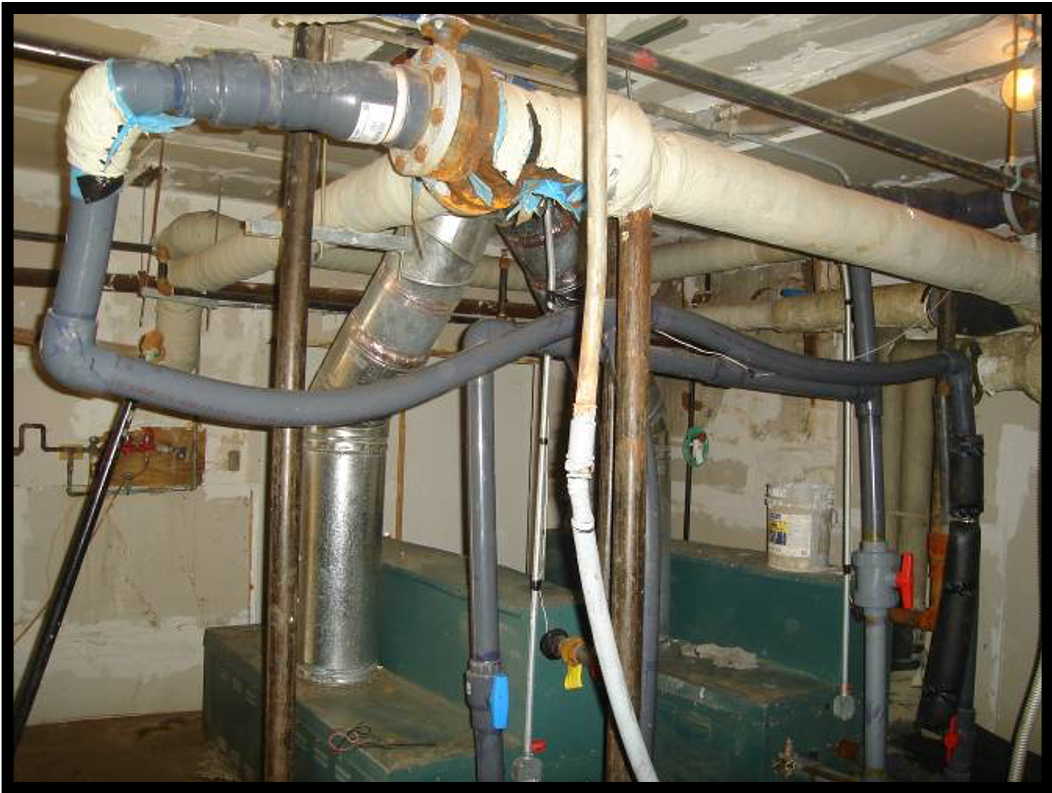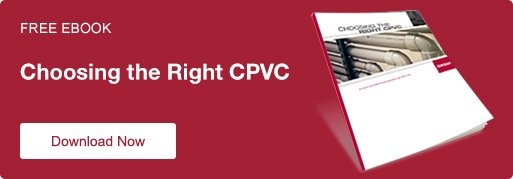Pipe Sag: Causes and Prevention
Basic principles of physics and thermodynamics dictate that the surface temperature of an industrial piping system when installed during ambient temperature conditions will change when it transitions to the operating state for which the system is designed. This is especially true if the piping system is installed during one season and goes into service in another. Outside installations are always subject to the thermal cycling of a typical day as well as seasonal climate cycling. In addition, our experience and understanding of external installations shows us that the solar energy of the sun can impact the surface temperature of piping in a pipe rack, adding heat that can lead to a total surface temperature significantly higher than the ambient temperature of the region.
Thus, if a piping run is constrained end to end and the temperature change is great enough, the result is linear expansion or contraction of the pipe and measures must be taken to accommodate this, including loops, offsets or changes in direction, to prevent undue stress to the system for the process conditions involved.
Avoid Sagging Pipes To Achieve Design Life
A separate principle not always given the attention it should be concerns the avoidance of sagging pipes. Regardless of what material is selected, an industrial piping layout that creates unnecessary stress on joints or excessive point loads, pushing toward a yield point, is to be avoided. The causes of sagging usually stem from a combination of factors, including temperature rises, inadequate support spacing, a methodology for piping support that allows too much or too little movement of the piping, and the presence of the expansion mitigations noted above.
An absolute prerequisite for combating sag is a well-designed support system to distribute the piping weight and the weight of the associated valves, fittings, insulation and the fluid carried by the pipe. Engineers typically address factors such as thermal expansion and contraction as part of the piping layout and support scheme. But they must also consider the system’s working stress and the how the material elongates or compresses when a force is applied.
As a well-trusted plastic piping material, CPVC’s modulus of elasticity is relatively low compared to that of metal pipes, which means it has the flexibility to absorb the shock from a less severe impact and, to some extent, can bounce back to its original shape without any structural damage. Shock transferred to the connecting system will also be minimal.
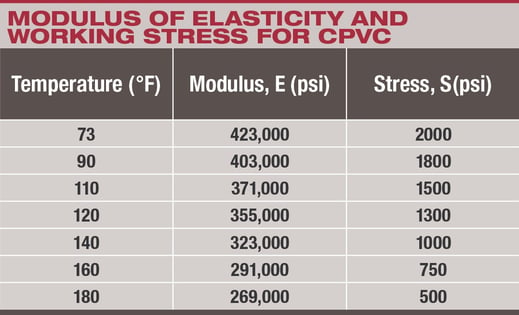
The Impact of Thermal Stress on CPVC vs. Steel
Because the coefficient of thermal expansion of steel is five times lower than that of CPVC, dimensional change due to thermal expansion will be five times less. However, the stresses induced in the piping system due to restrained thermal expansion are dependent on the material’s modulus as well as its coefficient of thermal expansion. Because the modulus of steel is approximately 80 times higher than that of CPVC, stresses resulting from restrained expansion over a given temperature change will be approximately 16 times higher for steel than for CPVC.
For instance, restrained expansion over a 50°F temperature change will produce approximately 600 psi of stress in a CPVC system, but 9800 psi of stress in a steel system. CPVC’s relatively more flexible nature enables it to absorb its lower stresses in a buckling or snaking of the line if necessary. Because steel piping is too rigid to buckle, its higher stresses are often transferred to surrounding structures, resulting in damaged supports, anchors or even abutting walls.
Why Design and Operations Teams Should Talk
Recognizing that specifying a piping material with a certain amount of natural flexibility, such as Corzan® CPVC, can help absorb deflections, it is still true that each industrial piping system will be uniquely subject to potential upset conditions that must be considered in the final design. It is critical to analyze the specific impact of these upset conditions upon the material’s yield point and make front-end allowances for them to avoid operational and basic safety problems.
One major perpetrator of an upset condition can occur as a result of neutralization methods used to clean lines before opening piping systems for maintenance inspections. This can also be an issue when rerouting the configuration of the line. Operational upsets that cause excessive temperature or exothermic reactions can be harmful to many systems. If engineers are diligent in their identification of upset conditions and facility neutralization techniques, they can incorporate accommodations for this into the design.
It is also worth noting that, all too often, the line cleaning practices of some facilities fail to take into account which neutralization procedures go with which piping materials. We have witnessed facilities introduce steam into a line that can’t handle that temperature, add caustic chemicals to neutralize acid and add acid to neutralize caustic. For example, the piping of an FRP system designed to handle acids will be comprised of specific resins selected to provide chemical resistance to, say, hydrochloric acid. That system should not be exposed to caustics. On the other hand, that same FRP piping system lined with Corzan CPVC has a tremendous advantage over other systems because it can withstand the full pH range of chemicals that could be required in neutralization.
Utilizing the recommended support spacings and adjustments to specific gravity of the medium (if other than water) can help prevent the sag. The recommended spacings of various types of hangers, clamps and supports by pipe size and temperature are shown below.
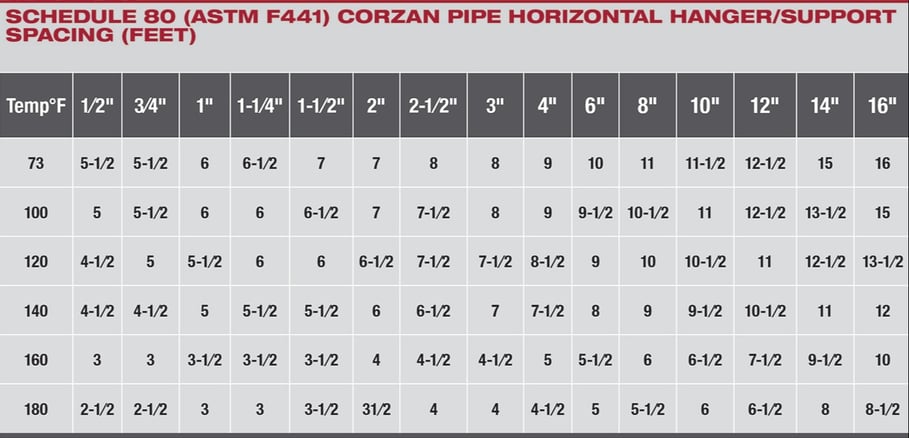
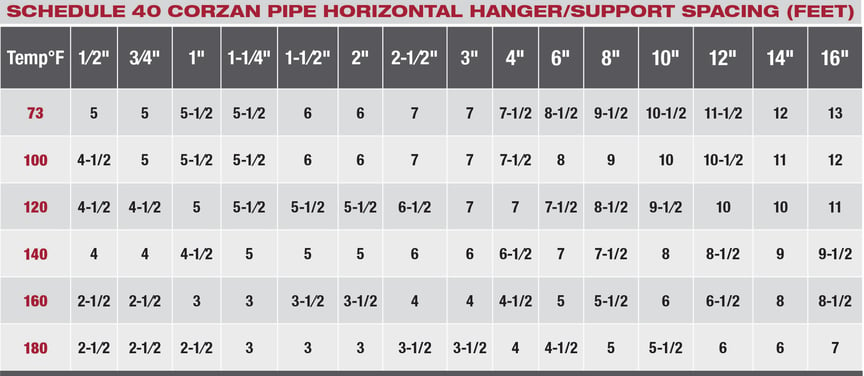
Getting Down to Basics: What Is My Plastic?
Corzan Industrial Systems offer superior resistance to corrosive chemicals, high temperatures and harsh application conditions. As a result, plastic pipe and fittings made from Corzan CPVC deliver what the process industry needs most – best in class impact strength, longer service life, lower maintenance costs and reduced downtime. All CPVC is not Corzan; Corzan CPVC is only manufactured by partner pipe companies meeting rigorous production and quality standards with a track record of reliability.
Unlike generic CPVC, Corzan CPVC is resin with a specified molecular weight and chlorine content plus additives to ensure long-term performance. It is formulated to achieve pressure ratings, tensile strength and impact strength for the finished product that exceed minimum applicable industry standards for thermoplastics. To guarantee consistent and high quality production, each of our manufacturers is contractually required to participate in Lubrizol Advanced Materials’ Quality Assurance Program. Corzan CPVC specifications are considered quality specifications with no equal. That is why Corzan CPVC is the most specified industrial grade CPVC piping technology in the world. This is just one of the important differentiators between Corzan CPVC and generic CPVC material.
And it’s important to know that every decision to work with Corzan Industrial Systems brings with it a commitment to offering dedicated support to ensure a smooth execution of the piping technology. Lubrizol Advanced Materials brings decades of industrial, plumbing and mechanical contracting experience in training and educating installers at the office or the jobsite. Likewise, project engineers can take advantage of our subject matter experts and ASPE-approved CEU course instructors – fulltime Lubrizol Advanced Materials employees who are industry experts and offer the most up-to-date training during every accredited session.
